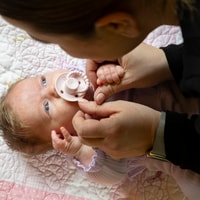Weather in Australia can get pretty extreme, so it only makes sense that a lot of families have questions about how to keep their baby’s sleep environment at the right temperature ☀️❄️
There’s no golden number when it comes to the temperature in a baby’s room, but most recommendations are between 18 and 22 degrees Celsius.
You definitely don’t have to fork out for an expensive climate control system for your baby’s sleep environment, as long as you are aware of some key points to help control your baby’s temperature.
Keeping blinds drawn in your baby’s sleep environment is a great way to keep it cool during those summer months, and to keep that lighting state consistent, too.
Clothing has a role to play, too. The number one piece of advice – in both Summer and Winter – is to keep your baby’s head uncovered – no hats, beanie, or hoods for bedtime. Babies lose heat through their heads, so keeping it uncovered prevents overheating. And, of course, a covering so close to their face can be a suffocation risk.
Aside from this, there are no hard-and-fast rules when it comes to dressing babies for sleep.
In Summer, you might choose to dress your baby in something like this:


